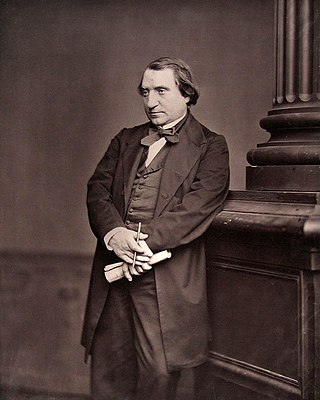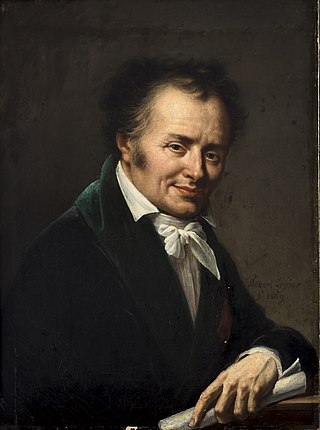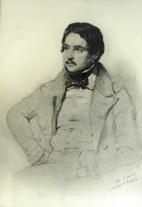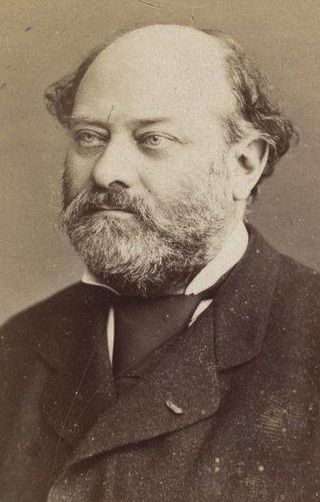
Henri René Albert Guy de Maupassant was a 19th-century French author, celebrated as a master of the short story, as well as a representative of the naturalist school, depicting human lives, destinies and social forces in disillusioned and often pessimistic terms.

Byblos, also known as Jebeil, Jbeil or Jubayl, is an ancient city in the Keserwan-Jbeil Governorate of Lebanon. The area is believed to have been first settled between 8800 and 7000 BC and continuously inhabited since 5000 BC. During its history, Byblos was part of numerous cultures including Egyptian, Phoenician, Assyrian, Persian, Hellenistic, Roman, Genoese, Mamluk and Ottoman. Urbanisation is thought to have begun during the third millennium BC and it developed into a city making it one of the oldest cities in the world. It is a UNESCO World Heritage Site.

Joseph Ernest Renan was a French Orientalist and Semitic scholar, writing on Semitic languages and civilizations, historian of religion, philologist, philosopher, biblical scholar, and critic. He wrote works on the origins of early Christianity, and espoused popular political theories especially concerning nationalism, national identity, and the alleged superiority of White people over other human "races". Renan is known as being among the first scholars to advance the debunked Khazar theory, which held that Ashkenazi Jews were descendants of the Khazars, Turkic peoples who had adopted the Jewish religion and allegedly migrated to central and eastern Europe following the collapse of their khanate.

Dominique Vivant, Baron Denon was a French artist, writer, diplomat, author, and archaeologist. Denon was a diplomat for France under Louis XV and Louis XVI. He was appointed as the first Director of the Louvre museum by Napoleon after the Egyptian campaign of 1798–1801, and is commemorated in the Denon Wing of the modern museum and in the Dominique-Vivant Denon Research Center. His two-volume Voyage dans la basse et la haute Egypte, 1802, was foundational for modern Egyptology.

Alain de Benoist, also known as Fabrice Laroche, Robert de Herte, David Barney, and other pen names, is a French political philosopher and journalist, a founding member of the Nouvelle Droite, and the leader of the ethno-nationalist think tank GRECE.

Kazimierz Józef Marian Michałowski was a Polish archaeologist and Egyptologist, art historian, member of the Polish Academy of Sciences, professor ordinarius of the University of Warsaw as well as the founder of the Polish Centre of Mediterranean Archaeology. He coined the term "Nubiology" to refer to the study of ancient Nubia.

The sarcophagus ofEshmunazar II is a 6th-century BC sarcophagus unearthed in 1855 in the grounds of an ancient necropolis southeast of the city of Sidon, in modern-day Lebanon, that contained the body of Eshmunazar II, Phoenician King of Sidon. One of only three Ancient Egyptian sarcophagi found outside Egypt, with the other two belonging to Eshmunazar's father King Tabnit and to a woman, possibly Eshmunazar's mother Queen Amoashtart, it was likely carved in Egypt from local amphibolite, and captured as booty by the Sidonians during their participation in Cambyses II's conquest of Egypt in 525 BC. The sarcophagus has two sets of Phoenician inscriptions, one on its lid and a partial copy of it on the sarcophagus trough, around the curvature of the head. The lid inscription was of great significance upon its discovery as it was the first Phoenician language inscription to be discovered in Phoenicia proper and the most detailed Phoenician text ever found anywhere up to that point, and is today the second longest extant Phoenician inscription, after the Karatepe bilingual.

Augustus Henry Julian Le Plongeon was a British-American antiquarian and photographer who studied the pre-Columbian ruins of America, particularly those of the Maya civilization on the northern Yucatán Peninsula. While his writings contain many notions that were not well received by his contemporaries and were later disproven, Le Plongeon left a lasting legacy in his photographs documenting the ancient ruins. He was one of the earliest proponents of Mayanism.

Charles Lenormant was a French archaeologist.
François Bon is a French writer and translator.
Antoine Guillaumont was a French archaeologist and Syriac scholar. He held positions notably at the École pratique des hautes études and the Collège de France, and was a member of the Académie des Inscriptions et Belles-Lettres. His archaeological writings are related to the site of Kellia in Lower Egypt. As a Syriacist he was most interested in early monasticism and in the reception of the writings of Evagrius Ponticus.
Ernest-Marie Laperrousaz was a French historian and archaeologist. As an archaeologist he worked at Qumran and Masada. He has published numerous books including works on Qumran and the context of the Dead Sea Scrolls.
Claude Sosthene Grasset d'Orcet was a French archaeologist, writer, exponent of the esoteric and founder of the study of French mythology.

Jean-Hippolyte Michon was a French priest, an archaeologist, and the founder of graphology.

Antoine Émile Ernest Desjardins was a French historian, geographer and archaeologist. He was a younger brother of historian Abel Desjardins (1814–1886).

Tanguy Viel is a French writer. A resident at the Villa Médicis in 2003–2004, Tanguy Viel was awarded the Prix Fénéon and the Prix littéraire de la vocation for his novel L'absolue perfection du crime. He also won the Grand prix RTL-Lire for Article 353 du Code pénal in 2017. Other Press in New York published the translation by William Rodarmor in March, 2019. La fille qu'on appelle was one of nine novels in the second selection for the 2021 Prix Goncourt.

Yves Berger was a French writer and editor. From 1960 to 2000, he was the literary director of Éditions Grasset, and published several novels in which he expressed his attachment to the United States.

Patrice Pluyette is a French writer.
Léonor de Récondo is a French violinist and writer.

Hortense Cornu was a French socialite, salonnière, writer, and translator who played a significant role in the culture and politics of the French Second Empire. The goddaughter and foster-sister of Napoléon III, their lifelong relationship was his "closest and most lasting friendship with a woman." As an avowed Republican, she clashed with the Emperor over his authoritarianism and was estranged from him for a period of time after his 1851 coup d'état, but in the end "no political differences were allowed to mar their friendship, which was deep and true..." She advocated various French archaeological expeditions and, amongst other contributions, was involved in founding the National Archaeological Museum, France.















